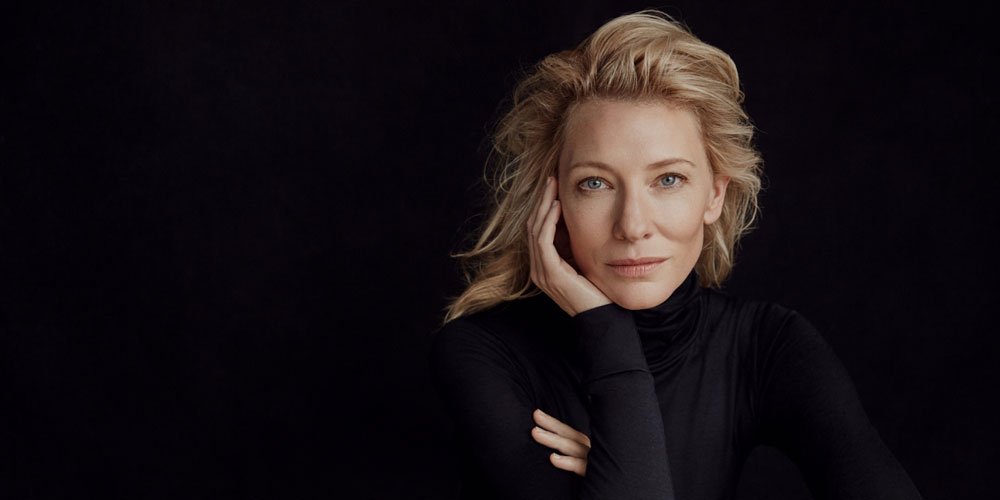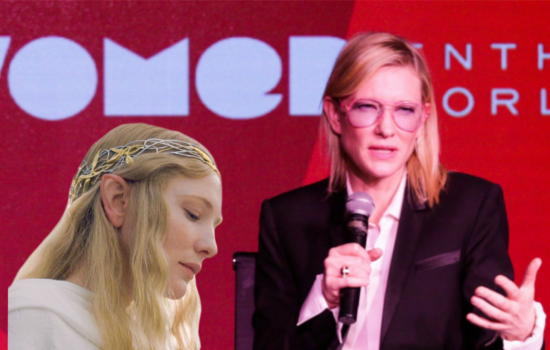Feather sleeves, faux tattoos, Jean Paul Gaultier chainmail and Iris van Herpen undulating material waves — Cate Blanchett has worn them all, and may again.
Days before she’s set into her new role as jury president of Venice Film Festival, which begins Sept. 2, the style icon is rethinking the red carpet’s relentless march of new, new, new.
Blanchett will be continuing the momentum from the last awards season into the next one — by re-wearing looks from her closet throughout the Venice Film Festival, which runs through Sept. 12. And she’s urging others to do the same. “This is not a mandate, it’s a provocation,” she says of her challenge to attendees of the socially distant fest, which will have a more low-key red-carpet scene on the Lido, but is still expected to draw stars of its 60 featured films, which include Tilda Swinton, Vanessa Kirby, Andrew Garfield, Adèle Exarchopoulos and Gia Coppola.
No newcomer to the sustainability cause, Blanchett and her husband playwright Andrew Upton spearheaded the Greening the Wharf initiative at the Sydney Theatre Company back in 2010. And she has reworn a few of her red-carpet greatest hits in the past. But COVID-19 and the climate catastrophe that has made it more likely for other infectious diseases to emerge from the natural world in the future have made her consider fashion’s impact on the environment even more urgently.
Over the past several years, the industry has pledged to reduce that impact, which amounts to as many carbon emissions annually as hwat France, Germany, and the United Kingdom emit combined, according to McKinsey. And Hollywood stars have become the faces for brands looking to showcase their efforts, most notably at the Oscars in February, which were the greenest yet fashion-wise.
But there is still a lot of work to be done. And Blanchett is excited by the challenge of continuing to weave sustainability into her fashion story.
A keen follower of design with a daring but decorous approach to dressing, the Oscar-winner has had a long, lucrative relationship with the industry, sitting front-row at Burberry and Givenchy, collaborating with Giorgio Armani and serving as the face of his Si fragrance campaigns. (On the subject of the Hollywood-fashion symbiosis, she says, “Machines don’t have to be pollutants.”)
Although there won’t be a red carpet for the virtual Emmys on Sept. 20, Blanchett is a front-runner to win for her role in the Netflix drama “Mrs. America,” about the movement to ratify the Equal Rights Amendment. “Much to my horror, I didn’t realize that equality wasn’t enshrined in the American Constitution and I wonder how this moment in human history would have unfolded differently if it was,” quips the native Australian, who is outspoken about women’s rights and has worked on behalf of refugees as a U.N Goodwill Ambassador.
In other Venice fashion news, Blanchett style collaborator Elizabeth Stewart’s Chic Relief and Hollywood costume designer Arianne Phillips’ RAD (Red Carpet Advocacy) charities are spearheading a fund-raising effort around the festival. Blanchett was the first to sign on, and will be donating the looks she re-wears to an auction with 100 percent of the proceeds going to causes fighting for gender and racial equality, U.N. Women and Facing History and Ourselves.
Here, WWD chats with Blanchett about her thoughts about the future of fashion, why re-wearing past looks is not a knock on the industry, her take on fashion masks and compulsive buying, and what she’d like to re-wear from her wardrobe.
WWD: Good morning, or evening, are you in the U.K.?
Cate Blanchett: Yes, are you in L.A.? How are thing in L.A.?
WWD: Well thankfully, L.A. is not on fire yet like Northern California.
C.B.: I tell you, the world is on fire. Doesn’t it feel already liek five years ago that the horrendous bush fires in Australia were taking place and here we are again heading into bushfire season. It’s heartbreaking.
WWD: It is, which leads in to the topic of climate change. All eyes are going to be on the Venice Film Festival, the first major film festival fo the COVID-19 era with live events and screenings. You have re-worn looks on the red carpet in the past, and sustainability has certainly been a topic around the red carpet for a few years now, particularly at last year’s Oscars and BAFTAs. Why are you coming out of the gate with this statement now?
C.B.: It’s something I’ve been interested in — built-in obsolescence and the counterpoint to that, which is durability and products that are made well. It feels like it’s been such a time of introspection and reflection over the last six months broadly, and I think there is incredible opportunity to reassess processes we’ve taken for granted that were dysfunctional and unsustainable. As you said, this is a tentative first step out of the gate for the film industry, in which I work, but there’s a lot of connected industries that are associated with a festival like Venice — travel, tourism, the red carpet and what that means as a showcase for talent and ideas. And it’s a wonderful time to reinvent that.
WWD: Can what actors wear on the red carpet help change the world?
C.B.: The world isn’t going to be changed by one simple display in one particular industry. What the pandemic has revealed, though, is that everything is connected, and profound change only comes about through collaboration. The language around climate change is always around sacrifice, not around possibility. It takes as much water to make a cotton T-shirt that will fall apart as one that is far more durable. And beautiful things can come out of sustainability.
WWD: When did the wastefulness of fashion really get to you?
C.B.: It’s in the foundation, but we’ve seen over the last decade it used to be seasonal, now it’s trans-seasonal, multiseasonal, and brands are designing for outlet stores. When you the know the world is consuming 18 billion pieces of clothing a year, which is up 400 percent from a decade ago, you think, this is not working. When I was in school, I was very gripped by the failure of the [late 19th, early 20th-century European] Arts and Crafts movement, that they wanted to bring back craftsmanship, and it was an antidote to the Industrial Revolution and the ugliness of mass production. They wanted to make beautifully crafted pieces of furniture available to more people, but of course, when we pay people properly these pieces become incredibly expensive. So it’s a complicated ecosystem to be reexamined. In a simple answer to your question, I’ve heard a lot of people say it’s the handbag. How many arms do I have? People say, “I bought it on impulse.” But no, it’s not an impulsive buy, it’s a compulsive buy. When compulsion takes over, therein lies the destruction of an industry.
WWD: A lot of it is about changing the mind-set that we need to have new, new, new all the time. How do we do that? It’s so tied up with the fashion system of seasonal collections, monthly magazines, weekly drops and more.
C.B.: There are some incredible artists working in the fashion industry, so it’s always a pleasure to wear their latest invention and exploration. You want to foster that and continue, but how do you figure out how to do that in way that’s positive for the planet and the workforce, and inclusive as well?
WWD: So what are you going to re-wear in Venice? Maybe you could do an ode to Giorgio Armani through the years. Or Italy? Certainly the fashion industry is hurting there and everywhere.
C.B.: It is and that’s the difficult thing, and it’s not some mandate we’re saying to everybody at the festival, “Though shalt re-wear.” It’s just where possible.
WWD: And it’s not a knock on the industry to re-wear what’s come before?
C.B.: Oh no! Whenever I’ve talked to designers about it, they’ve been really supportive. I do think most houses are engaged in the idea of sustainability, but it’s how do we turn our business model around. That can’t be done in 24 hours, but it must be done. I’ve talked about it with Mr. Armani and Sarah Burton [of Alexander McQueen], and I’ve been talking a long time with Roksanda [Ilincic] about how we could do some sort of collection together that celebrates the recycling and repurposing of fabrics. And the people at Eco-Age have been huge champions of this. There’s a lot of movement afoot.
WWD: Certainly, Hollywood gets a lot of visibility and income from the fashion industry, and vice-versa, so the Hollywood fashion machine is likely to continue…
C.B.: But machines don’t have to be pollutants. There are beautiful machines like the human mind! And when you do try to reimagine things, it’s much more creative and everything is up for grabs, as it seems to be in this climate. Those of us who aren’t frontline workers, who aren’t ill, it’s up to us to reimagine new solutions.
WWD: When it comes to deciding what you’re going to re-wear on the red carpet, how do you remember what you have? I’m guilty of that and I don’t have your wardrobe!
C.B.: Quite a few phone calls, because having moved countries, I have beautiful things that are in museum boxes in storage in Sydney but with COVID-19 restrictions, I can’t get in and get them. And when you are talking about sustainability do you really want to fly a dress halfway around the world? I am working with what I’ve got in the attic. It’s an opportunity to clear the cobwebs out and see what I’ve got. And it’s fun, I remember seeing my mother’s wedding dress, and it was the first time in my life I truly appreciated the history of a garment. So whenever you do re-wear something, you have this shadow memory of the time you wore it before.
WWD: Tell me about your mother’s wedding dress.
C.B.: It was Sixties, very slim and Audrey Hepburn-esque, and it had this ivory satin top and a pillbox with a veil.
WWD: That would be cool if you could start a trend of people re-wearing wedding dresses on the red carpet.
C.B.: I know, I would love to re-wear the coat I wore on my wedding day, too; I spent my last savings on this coat, and left it with a family friend when [my husband] Andrew and I went off traveling. When I went to pick up my coat, because it was a peacoat, my friend thought it was one of her children’s and gave it away to a jumble sale! I was heartbroken. My sheath dress was made by the seamstress at the Sydney Theatre Company.
WWD: Will you be wearing a red-carpet mask in Venice?
C.B.: [Venice Film Festival director] Alberto Barbera is really bold in having the festival but cautious, so it’s going to be socially distant. Masks I’m sure will be worn. I went into a store the other day and saw what I thought was a whole pile of cod pieces in these amazing fabric remnants and of course, it turns out they were masks!
WWD: It’s a new stream of revenue for fashion.
C.B.: It’s like the mask has become a little haiku of recycling and repurposing. There’s been a lot of discourse about what one could make a mask out of, people are being inventive and there is a lot of home crafting going on.
WWD: I know you want to encourage other actors to re-wear at the festival. What would you say to them?
C.B.: In order to move forward, it’s a gift to be able to look back. As we reemerge, it’s a chance to reassess — and cinema is always doing that, looking back on its past, paying homage and using that inspiration to forge new moments. Look at “Hamlet,” we retell that story over and over, and each time we tell it there’s new things to be found. And this is not some strange club. I’m not the only person doing this. It’s a chance to do something positive. It’s not a mandate, it’s a provocation. I feel like people walk out of the house feeling like they have to shop the looks rather than work out which pieces they like, which is how you develop individual style.
WWD: Certainly we are in a time of great turmoil, particularly in the U.S. What’s made you feel good lately? Watching the astronauts on the SpaceX flight and thinking about them shooting for Mars was inspiring to me.
C.B.: Swimming in the ocean. I went surfing with my kids the other day. There’s something that happens in the surf. It’s invigorating. And trees. The wonderful thing about the U.K. is you can actually walk across it. What’s kept you going? Flying to Mars?
WWD: Yes, because at least if this planet becomes uninhabitable, we can go somewhere else!
C.B.: Maybe the chief executive officers of the top five multinationals! Although, I don’t know that Mars would want us. That’s an act of hubris right there!
Source: WWD
 Welcome to Cate Blanchett Fan, your prime resource for all things Cate Blanchett. Here you'll find all the latest news, pictures and information. You may know the Academy Award Winner from movies such as Elizabeth, Blue Jasmine, Carol, The Aviator, Lord of The Rings, Thor: Ragnarok, among many others. We hope you enjoy your stay and have fun!
Welcome to Cate Blanchett Fan, your prime resource for all things Cate Blanchett. Here you'll find all the latest news, pictures and information. You may know the Academy Award Winner from movies such as Elizabeth, Blue Jasmine, Carol, The Aviator, Lord of The Rings, Thor: Ragnarok, among many others. We hope you enjoy your stay and have fun! 



 A Manual for Cleaning Women (202?)
A Manual for Cleaning Women (202?) The Seagull (2025)
The Seagull (2025) Bozo Over Roses (2025)
Bozo Over Roses (2025) Black Bag (2025)
Black Bag (2025)  Father Mother Brother Sister (2025)
Father Mother Brother Sister (2025)  Disclaimer (2024)
Disclaimer (2024)  Rumours (2024)
Rumours (2024)  Borderlands (2024)
Borderlands (2024)  The New Boy (2023)
The New Boy (2023) 











